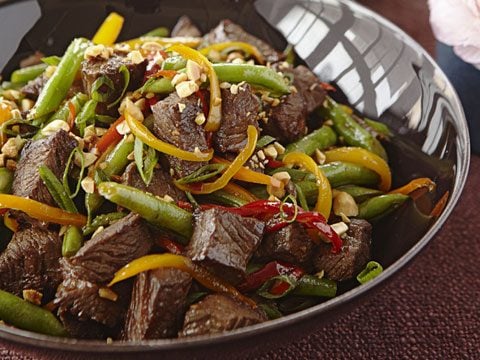How to Order the Healthiest Chinese Food
Updated: Feb. 25, 2021

What to look for, what to skip, and tips for placing a healthier order the next time you take out from a Chinese restaurant.
Our editors and experts handpick every product we feature. We may earn a commission from your purchases.
The traditional Chinese diet is a healthy one, with lots of vegetables, stir-fries with small chunks of meat or fish, and soy foods. But that’s not always evident in the typical fare in a Chinese restaurant in the United States, where the meal is likely to be heavy on greasy meats and swimming in sauces with lots of calories. Even the vegetables are usually in a fatty, sugary sauce. If you’re looking to eat healthy, do you have to give up Chinese takeout? Of course not. “While there are definitely loads of options at Chinese restaurants that are heavy on greasy meats and swimming in sauces, it is doable to choose a healthy meal,” says Patricia Bannan, RDN, author of Eat Right When Time is Tight and a dietitian in Los Angeles.
1. Ask for brown rice. Most restaurants give you the option, and white rice is a blood-sugar disaster waiting to happen. Don’t eat the whole bowl or container of rice; spoon a half cup onto your plate and leave the rest. You can also do as a Chinese native would: Put a small amount of brown rice in a small bowl and hold the bowl up, using your chopsticks (or fork) to eat a little rice in between bites of your main dish. You can also skip the rice altogether, and fill up on fiber-friendly vegetables instead.
2. Start with soup. Wonton, egg drop, or hot-and-sour soup are good choices. A small bowl of soup will take the edge off your hunger and not make a big dent in your calorie intake. Another good appetizer choice is steamed vegetable dumplings—steer clear of pan-fried ones.
3. Look for light options. When it comes to entrées, “opt for a steamed entree option such as chicken or tofu and mixed vegetables,” says Bannan. “This eliminates the extra fat and calories from being deep fried or cooked in a heavy amount of oils and sauces.” Peruse the options from the “health” menu. Here is where you’ll find similar low-fat choices. Another good choice is moo goo gai pan (chicken with mushrooms). If you like stir-fries, ask the waitperson to have yours prepared with less oil and more veggies. And “ask for a side of your favorite sauce or soy sauce to control how much you add, which can also control the amount of added sodium,” adds Bannan. “I always ask for the low-sodium soy sauce, which is available at most Chinese restaurants.”
4. Make sure you order plenty of vegetables. If you really want to make the meal healthier, order a plate of steamed vegetables and add them to other dishes. Or ask for sautéed vegetables or Szechuan-style string beans.
5. Take advantage of the bean curd (tofu). Include a heart-healthy dish like bean curd with sautéed Chinese mixed vegetables (ask for sautéed bean curd, not deep-fried).
6. Plan to take home leftovers. Portions are often large. Think of about a cup of a dish (without rice) as a serving.
7. Just Say No
- Crispy noodles
- Egg rolls
- Fried wontons
- Fried rice
- Pan-fried noodles
- Lo mein
- Crispy beef or chicken
- Sweet-and-sour pork, chicken, and other meat dishes
- Szechuan spicy fish
- General Tso’s chicken
- Kung pao chicken
- Spicy eggplant
See Also:












